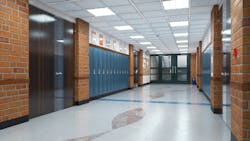Carpet? Resilient flooring? Something else?
Facility planners must consider an assortment of factors when deciding the type of flooring to be used in a school space: What activities will take place there? How does it look? How much does it cost? How long will it last? How difficult is it to clean? Will it affect the health and safety of students, teachers or other employees? What is its environmental impact?
“Flooring should be durable to withstand heavy use without requiring frequent replacement, be easy to maintain, contain recycled content, be recyclable, contribute to a comfortable indoor environment, and not adversely affect human health,” says the U.S. Department of Energy’s National Best Practices Manual for Building High Performance Schools.
Carpeting and resilient flooring are the most common flooring types found in school facilities. The Best Practices Manual lists those and other flooring types that schools may have in place in their buildings and looks at the some of the advantages and disadvantages of each.
•Carpet, the manual says, is most suitable for classrooms, libraries and administrative areas. It provides acoustic benefits not available with other flooring types and retains heat longer than most resilient flooring.
Schools opting for carpet as a flooring choice should select products that are durable, have low emissions of volatile organic compounds, are made with recycled content and can be easily cleaned.
A potential disadvantage is that allergens such as dirt, pollen, mold spores, pesticides and other toxins, may be tracked in via people’s shoes and trapped in carpeting. Old carpeting may have microbial contamination because of water infiltration or inadequate cleaning that could lead to air quality problems.
“Carpet requires regular vacuuming with a well-functioning vacuum cleaner equipped with strong suction and a high-performance filtration bag,” the manual says. “…If regular, effective maintenance and cleaning cannot be assured, carpeting should not be used.”
•Resilient flooring, the manual states, is best suited “for high-traffic areas not requiring the acoustic benefits of carpet, such as hallways, kitchens, cafeterias, art rooms, toilets or anywhere that liquid spills are likely.”
It is more easily cleaned than carpeting and may last considerably longer.
Vinyl composition tile has been the primary choice for uncarpeted areas of schools because of its high durability and low maintenance, the manual says. The downside is that is made of non-renewable resources. One alternative is linoleum, which is made from minimally processed, renewable materials, but the manual warns that it may have “an offensive odor during its early months and sometimes, much longer.”
Another potential concern is that the products used to clean and maintain resilient flooring may be significant sources of pollution.
•Terrazzo and ceramic tile are most suitable for areas that require high durability and low maintenance, but do not need the acoustic benefits of carpet.
The manual recommends cementitious terrazzo, which is composed of inert ingredients mixed with water, over epoxy terrazzo, which contains a number of toxic materials. The primary installation hazard with cementitious terrazzo is dust during mixing and grinding, and the installation of epoxy terrazzo requires the use of OSHA-approved respirators, protective gloves, and safety glasses, as well as ventilation with 100% fresh air.
“For these reasons, use of the epoxy-type terrazzo should be avoided,” the manual recommends.
•Concrete flooring is especially suitable for high-traffic areas, such as hallways, cafeterias and gathering areas. The manual recommends using concrete made with fly ash. Because concrete floors are low maintenance, there is less reliance on cleaning and maintenance products that could cause air quality problems. However, concrete floors do not absorb sound or reduce noise transmission to spaces below
•Wood flooring may be the choice “where its performance characteristics make it uniquely desirable,” the manual says. Those spaces include gymnasiums, stages and dance studios. Environmentally preferable wood flooring types include Forest Stewardship Council (FSC)-certified hardwood, salvaged wood, and laminated or veneered wood products.
The manual warns that if sanding of wood flooring is done on the premises of a school, the area must be isolated, including sealing off the doors and HVAC system, and using fans to ventilate the space
•Bamboo is suitable for flooring wherever would flooring would be used.
“Bamboo flooring is aesthetically pleasing, low emitting…harder than most common wood flooring, very durable, and fast-growing,” the manual says. “…It is a renewable resource, requiring no pesticides, fertilizers or irrigation, so it is not labor intensive to farm.”
The manual also cites high cost as a potential drawback for bamboo, wood and terrazzo flooring.
No matter what type of flooring found in a school, walk-off mats are recommended for all entrances to help minimize contamination from pollutants brought into a building on the shoes of students and staff.
“Using walk-off mats to trap dirt, dust, grit, and moisture can also reduce maintenance costs, improve safety, and protect the life and appearance of the flooring,” the manual says.
How well a flooring surface performs and lasts in a school building also is heavily dependent on having an effective maintenance plan in place.
“Regardless of floor covering type specified, regular and effective cleaning and maintenance is essential to keep the floor covering dry and clean,” the EPA says. “Designers should explicitly consider cleaning and maintenance issues when specifying flooring finishes for various uses in schools.”
About the Author
Mike Kennedy
Senior Editor
Mike Kennedy, senior editor, has written for AS&U on a wide range of educational issues since 1999.
